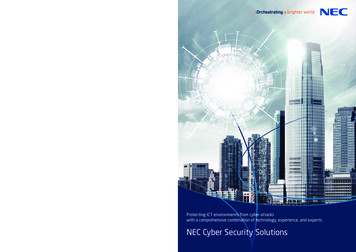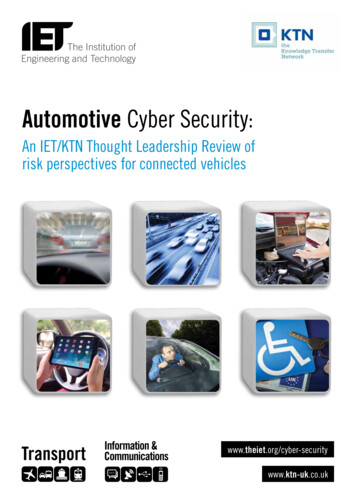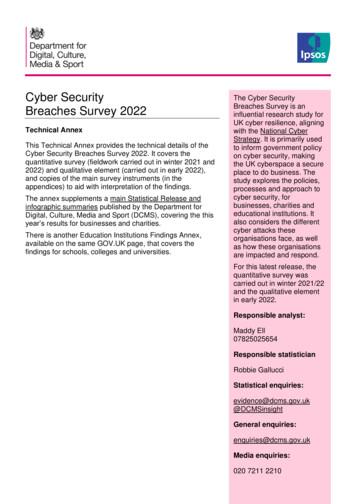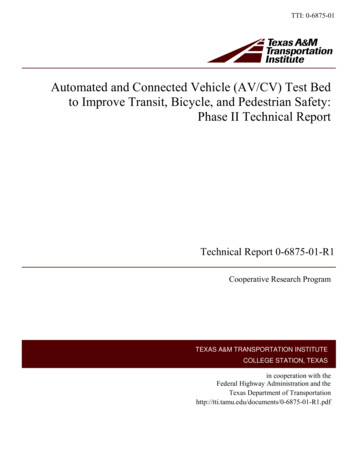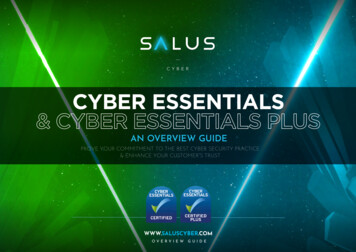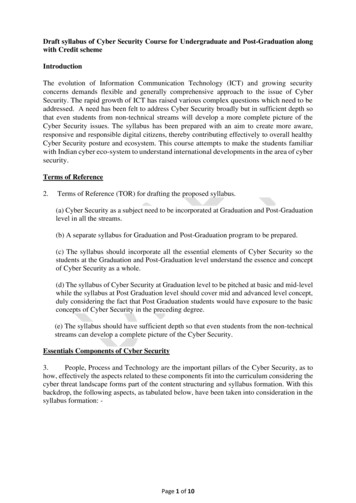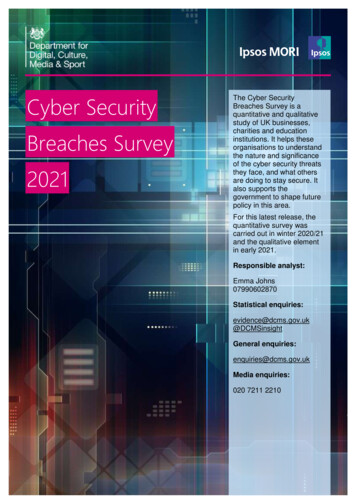
Transcription
The Key Principles of Cyber Securityfor Connected and Automated VehiclesGovernment
ContentsIntelligent Transport System (ITS) & Connected and Automated Vehicle(CAV) System Security Principles: 1. Organisational security2 2. Security risks are assessed5 3. Organisations product aftercare6ITS/CAV System Design Principles: 4. Organisations working together9 5. System Defence10 6. Software Security13 7. Data storage and transmission14 8. Resiliently designed systems17Troubleshooting
1As vehicles get smarter, cyber security in the automotive industry isbecoming an increasing concern. Whether we’re turning cars intoWi-Fi connected hotspots or equipping them with millions of lines ofcode to create fully autonomous vehicles, cars are more vulnerablethan ever to hacking and data theft.It’s essential that all parties involved in the manufacturing supply chain,from designers and engineers, to retailers and senior level executives,are provided with a consistent set of guidelines that support this globalindustry. The Department for Transport (DfT), in conjunction with theCentre for the Protection of National Infrastructure (CPNI), have createdthe following key principles for use throughout the automotive sector,the CAV and ITS ecosystems and their supply chains.
Principle 1Organisational security is owned, governed and promoted at board level.Principle 1.1Principle 1.2Principle 1.3Principle 1.4There is a securityprogram which is alignedwith an organisation’sbroader mission andobjectives.Personal accountabilityis held at the boardlevel for product andsystem security (physical,personnel and cyber) anddelegated appropriatelyand clearly throughoutthe organisation.Awareness and trainingis implemented to embeda ‘culture of security’to ensure individualsunderstand their role andresponsibility inITS/CAV System security.All new designs embraceSecurity by Design.Secure design principlesare followed in developinga secure ITS/CAV System,and all aspects of security(physical, personnel andcyber) are integrated intothe product & servicedevelopment process.2Intelligent Transport System (ITS) & Connected and Automated Vehicle (CAV) System Security Principles Organisational Security
References: Cyber Essentials and 10 Steps, Security by Design, ISO 27001, HMG Security policy framework, NIST SP 800-503
4Intelligent Transport System (ITS) & Connected and Automated Vehicle (CAV) System Security Principles Security risks assessed
Principle 2Security risks are assessed and managed appropriately and proportionately, including those specific to the supply chain.Principle 2.1:Organisations must require knowledge and understandingof current and relevant threats and the engineeringpractices to mitigate them in their engineering roles.Principle 2.2:Organisations collaborate and engage with appropriatethird parties to enhance threat awareness and appropriateresponse planning.Principle 2.3:Security risk assessment and management procedures arein place within the organisation. Appropriate processes foridentification, categorisation, prioritisation, and treatment ofsecurity risks, including those from cyber, are developed.Principle 2.4:Security risks specific to, and/or encompassing, supplychains, sub-contractors and service providers areidentified and managed through design, specificationand procurement practices.References: Def Stan 05-138, ISO 15408, ISO 27002, ISO 27010, ISO 27034, NIST800-30, PAS 1192-55
Principle 3Organisations need product aftercare and incident response to ensure systems are secure over their lifetime.Principle 3.1Principle 3.2Principle 3.3Principle 3.4Organisations plan forhow to maintain securityover the lifetime of theirsystems, including anynecessary after-salessupport services.Incident response plansare in place. Organisationsplan for how to respond topotential compromise ofsafety critical assets,non-safety criticalassets, and systemmalfunctions, and how toreturn affected systems to asafe and secure state.There is an activeprogramme in placeto identify criticalvulnerabilities andappropriate systems inplace to mitigate them ina proportionate manner.Organisations ensuretheir systems are able tosupport data forensicsand the recovery offorensically robust, uniquelyidentifiable data. This maybe used to identify thecause of any cyber, orother, incident.62Intelligent Transport System (ITS) & Connected and Automated Vehicle (CAV) System Security Principles Organisations Product Aftercare
References: NIST SP 800-61, ISO 270357
8ITS/CAV System Design Principles Organisations working together
Principle 4All organisations, including sub-contractors, suppliers and potential 3rd parties, work together to enhance the security of the system.Principle 4.1:Organisations, including suppliers and 3rd parties, must beable to provide assurance, such as independent validationor certification, of their security processes and products(physical, personnel and cyber).Principle 4.2:It is possible to ascertain and validate the authenticity andorigin of all supplies within the supply chain.Principle 4.3:Organisations jointly plan for how systems will safely andsecurely interact with external devices, connections(including the ecosystem), services (including maintenance),operations or control centres. This may include agreeingstandards and data requirements.Principle 4.4:Organisations identify and manage external dependencies.Where the accuracy or availability of sensor or externaldata is critical to automated functions, secondary measuresmust also be employed.References: Def-Con 05-138, ISO 12207, ISO 27001, ISO 270029
Principle 5Systems are designed using a defence-in-depth approach.Principle 5.1Principle 5.2Principle 5.3Principle 5.4The security of the systemdoes not rely on singlepoints of failure, securityby obscuration or anythingwhich cannot be readilychanged, should it becompromised.The security architectureapplies defence-in-depth& segmented techniques,seeking to mitigate riskswith complementarycontrols such as monitoring,alerting, segregation,reducing attack surfaces(such as open internetports), trust layers/boundaries and othersecurity protocols.Design controls tomediate transactionsacross trust boundaries,must be in place throughoutthe system. These includethe least access principle,one-way data controls,full disk encryption andminimising shareddata storage.Remote and back-endsystems, including cloudbased servers, which mightprovide access to a systemhave appropriate levels ofprotection and monitoringin place to preventunauthorised access.1062Intelligent Transport System (ITS) & Connected and Automated Vehicle (CAV) System Security Principles Security software
References: SAE J3061, SAE J3101, ISO 15408, ISO 27034, ISO 2911911
12ITS/CAV System Design Principles Resilient designed system
Principle 6The security of all software is managed throughout its lifetime.Principle 6.1:Organisations adopt secure coding practices toproportionately manage risks from known and unknownvulnerabilities in software, including existing code libraries.Systems to manage, audit and test code are in place.Principle 6.2:It must be possible to ascertain the status of allsoftware, firmware and their configuration, including theversion, revision and configuration data of all softwarecomponents.Principle 6.3:It is possible to safely and securely update software andreturn it to a known good state if it becomes corrupt.Principle 6.4:Software adopts open design practices and peer reviewedcode is used where possible. Source code is able to beshared where appropriate.References: Microsoft SDL, SAFE Code best practices, OWASP CLASP, ISO 12207, PAS 75413
Principle 7The storage and transmission of data is secure and can be controlled.Principle 7.1Principle 7.2Principle 7.3Data must be sufficientlysecure (confidentiality andintegrity) when stored andtransmitted so that only theintended recipient or systemfunctions are able to receiveand/or access it. Incomingcommunications are treatedas unsecure until validated.Personally identifiabledata must be managedappropriately. This includes:what is stored (both on and offthe ITS/CAV System); what istransmitted; how it is used andthe control the data owner hasover these processes. Wherepossible, data that is sent toother systems is sanitised.Users are able to deletesensitive data, such aspersonally identifiabledata, held on systemsand connected systems.1462Intelligent Transport System (ITS) & Connected and Automated Vehicle (CAV) System Security Principles Defence systems
References: NIST 800-88, ISO 9797-1, ISO 27002, ISO 2701815
16ITS/CAV System Design Principles Data storage and transmission
Principle 8The system is designed to be resilient to attacks and respond appropriately when its defences or sensors fail.Principle 8.1:The system must be able to withstand receiving corrupt,invalid or malicious data or commands via its external &internal interfaces while remaining available for primary use.This includes sensor jamming or spoofing.Principle 8.2:Systems are resilient and fail-safe if safety-criticalfunctions are compromised or cease to work.The mechanism is proportionate to the risk. The systemsare able to respond appropriately if non-safety criticalfunctions fail.Reference: ISO 9797-117
Troubleshooting Applicable Standards and Guidance*:SAE J3061 - Cybersecurity guidebook for cyber-physical vehicle systems. J3101 - Requirements for hardware protected security for ground vehicle applications.ISO 9797-1 – Security techniques: Message authentication codes – specifies a model for secure message authentication codes using block cyphers and asymmetric keys. 12207 – Systems and software engineering – software lifecycle processes. 15408 – Evaluation of IT security – specifies a model for evaluating security aspects within IT. 27001 – Information security management system. 27002 – Code of practice – security – provides recommendations for information management. Contains guidance on access control, cryptography & supplier relationship. 27010 – Information security management for inter-sector and inter-organizational communications. 27018 – Code of practice – handling PII / SPI (Privacy) – Protection of Personally Identifiable Information (PII) in public clouds. 27034 – Application security techniques – guidance to ensure software delivers necessary level of security in support of an organisations security management system. 27035 – Information security incident management. 29101 – Privacy architecture framework. 29119 – Software testing standard.DEFSTAN 05-138 – Cyber security for defence suppliers.NIST 800-30 - Guide for conducting risk assessments. 800-88 - Guidelines for media sanitization. SP 800-50: Building an information technology security awareness and training program. SP 800-61: Computer security incident handling guide.Other Microsoft Security Development Lifecycle (SDL). SAFE Code best practices. OWASP Comprehensive, Lightweight Application Security Process (CLASP). HMG Security policy framework. PAS 1192-5 – BSI publication on security-minded building information modelling, digital built environments and smart asset management. PAS 754 – BSI publication on Software Trustworthiness, governance and management.NCSC Cyber Essentials and 10 steps. To download a copy visit gov.uk. For further info contact cyber@dft.gsi.gov.uk.*This list is not intended to be exhaustive. Further standards and guidance may be applicable. It is recommended that for specific technologies or processes corporationsshould check for any applicable standards or guidance that might be of relevance and for any new standards that have been developed in the field.
Awareness and training is implemented to embed a 'culture of security' to ensure individuals understand their role and responsibility in ITS/CAV System security. . BSI publication on security-minded building information modelling, digital built environments and smart asset management. PAS 754 - BSI publication on Software .


